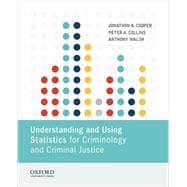Understanding and Using Statistics for Criminology and Criminal Justice shows students how to critically examine the use and interpretation of statistics, covering not only the basics but also the essential probabilistic statistics that students will need in their future careers. Taking a conceptual approach, this unique text introduces students to the mindset of statistical thinking. It presents formulas in a step-by-step manner; explains the techniques using detailed, real-world examples; and encourages students to become insightful consumers of research.
FEATURES
* Assumes minimal knowledge of math and is accessible to students at all levels
* Incorporates examples from real journals, showing how statistics are used in practice
* Explains the purpose of hypothesis testing more clearly than any other text, clarifying the concept of probability and its relationship to statistics
* Call-out boxes provide more in-depth explanations of concepts








